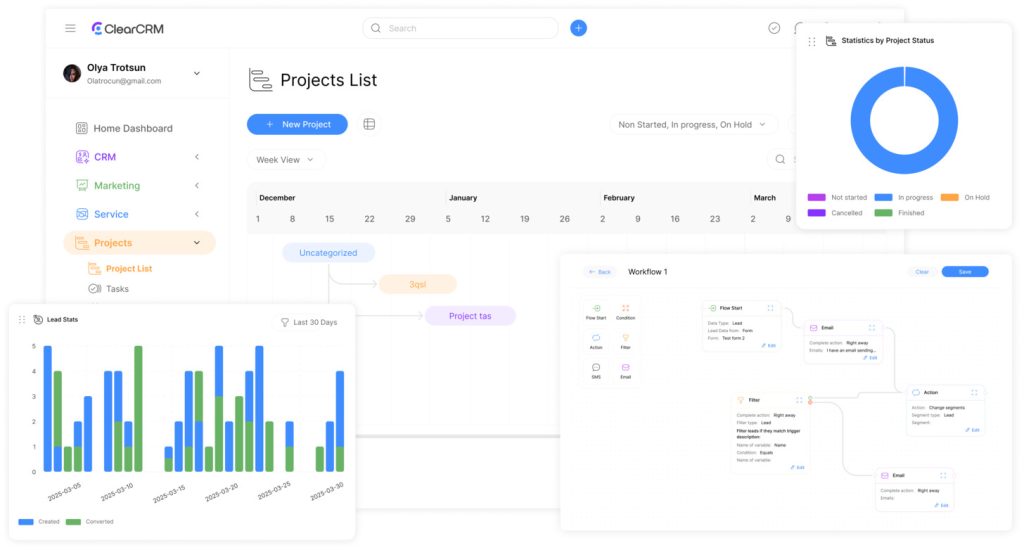Project Tracking & Reporting: Ultimate Guide for Success

Many professionals view status updates as tedious paperwork, but project tracking & reporting plays a critical role in ensuring project success. Whether you’re managing a software rollout or a construction initiative, structured systems make it easier to track project status, project goals, and resource usage in real time.
Organizations that adopt formal project reporting methods achieve 23% higher success rates than those using informal approaches, according to industry research. These systems not only track progress but also help identify risks early, ensure budget control, and align all team members toward shared outcomes.
Effective systems provide complete visibility into budgets, deadlines, and team performance. Decision-makers gain actionable insights to optimize resource allocation while maintaining stakeholder alignment. Automated tools now bring enterprise-level capabilities to businesses of all sizes, eliminating time-consuming manual processes.
Remote teams particularly benefit from centralized progress dashboards. These platforms replace lengthy meetings with instant access to critical updates, ensuring all members work from the same information. The result? Faster problem-solving and consistent momentum toward shared objectives.
Key Takeaways
- Formal progress systems boost project success rates by 23% compared to informal methods
- Real-time data enables early issue detection and proactive course corrections
- Automated tools provide enterprise-grade monitoring for teams of all sizes
- Centralized dashboards improve remote collaboration and decision speed
- Visibility into budgets and timelines supports strategic resource allocation
- Modern solutions reduce administrative work while increasing accountability
Understanding Project Tracking & Reporting

Navigating a complex overall project requires more than intuition—it requires clear, measurable insights. Think of project tracking as your team’s compass, helping you compare current progress with predefined project goals. Modern tools highlight bottlenecks, allowing you to identify areas of concern and respond before delays escalate.
Effective project tracking & reporting starts with measurable milestones that break large objectives into manageable steps. Weekly check-ins provide clarity on project timeline adherence, resources used, and budget consumption. This structured approach improves project health and enables accurate decision-making at every stage.
Defining the Essentials of Progress Monitoring
Effective systems start with measurable milestones that break large goals into achievable steps. Teams benefit from weekly check-ins that assess task completion rates and resource consumption. A marketing team launching a campaign might track daily engagement metrics against quarterly targets, adjusting strategies based on real-time feedback.
Centralized dashboards transform raw numbers into visual insights. These tools highlight patterns like repeated delays in specific phases or budget overruns. Managers spot trends faster than manual reviews allow, enabling swift corrective actions.
Key Components and Metrics
Critical measurements include:
- Timeline adherence: Percentage of tasks completed on schedule
- Resource efficiency: Budget vs. actual spending comparisons
- Team capacity: Workload distribution across members
Data quality determines success. Automated tools reduce human error in status updates, while standardized reporting formats ensure consistency. Teams using unified platforms resolve issues 40% faster according to recent industry surveys, as everyone accesses identical information.
Adaptability separates functional systems from rigid protocols. When client priorities shift, agile frameworks allow quick reprioritization without derailing entire operations. This flexibility maintains momentum despite unexpected challenges.
The Role of Reports in Driving Project Success
Forward-thinking organizations treat reports as strategic assets rather than administrative obligations. These dynamic tools convert scattered data into coherent narratives, empowering teams to maintain alignment and momentum.
Overview of Effective Project Reports
High-impact documents focus on forward-looking metrics instead of past events. They combine real-time updates with predictive analytics, offering stakeholders a clear view of timelines and resource needs. For example, a construction team might track daily material usage against weather forecasts to adjust schedules proactively.
| Report Component | Purpose | Impact |
|---|---|---|
| Predictive Analytics | Identify potential delays | Reduces timeline overruns by 35%* |
| Visual Dashboards | Simplify complex data | Cuts analysis time by 50% |
| Risk Heatmaps | Highlight vulnerabilities | Improves mitigation success rates |
Using Reports to Predict and Prevent Issues
Advanced systems analyze patterns in task completion rates and resource consumption. Metrics like timeline variance percentages and budget burn rates signal emerging challenges weeks before critical deadlines. “Our weekly review spotted a vendor delay three weeks early,” notes a tech startup operations lead. We rerouted shipments without missing milestones.”
Automated alerts notify managers when metrics breach predefined thresholds. This approach transforms reactive firefighting into strategic prevention, preserving stakeholder confidence. Teams maintain focus on deliverables while systems handle early warnings.
Benefits of Transparent Project Reporting

Clear visibility into operations separates thriving teams from struggling ones. Transparent systems turn raw data into actionable intelligence, empowering organizations to align efforts with strategic goals. Over 60% of managers in a recent survey credit open reporting practices with reducing miscommunication across departments.
Enhancing Team Accountability
When team members see their contributions mapped to broader objectives, ownership increases naturally. Digital dashboards display real-time progress metrics, creating friendly competition among colleagues. “Our completion rates jumped 18% after implementing visible performance boards,” shares a logistics company supervisor.
Key advantages include:
- Automated task attribution eliminates confusion about responsibilities
- Historical project data reveals patterns in individual work habits
- Public recognition systems motivate consistent high performance
Improving Resource Planning and Budget Tracking
Dynamic reporting tools transform financial oversight from guesswork to precision. Teams using visual budget trackers spot cost trends three weeks faster than those relying on spreadsheets. This early detection prevents minor overruns from becoming fiscal crises.
Effective resource management relies on:
- Time-tracking integrations that show capacity gaps
- Forecasting models based on historical resource usage
- Alert systems for project budget thresholds
Manufacturing firms using these techniques report 27% fewer material shortages. The right tools turn planning from reactive scrambling to strategic foresight.
Selecting the Right Project Management Software
Effective team coordination demands tools that match organizational complexity. The right management software acts as a digital command center, merging critical functions into a single interface. Leaders who implement tailored solutions see 31% faster decision-making compared to manual methods, per recent tech industry surveys.
Critical Components for Modern Teams
Powerful platforms balance depth with simplicity. Task management systems should allow drag-and-drop prioritization and deadline alerts. A construction firm manager notes: “Our workflow improved overnight when we could visualize dependencies across subcontractors.”
Essential capabilities include:
- Cross-platform integration: Syncs with email, calendars, and cloud storage
- Customizable dashboards: Displays real-time metrics specific to roles
- Automated alerts: Flags budget overruns before they escalate
Security remains non-negotiable. Role-based access controls and encryption protect sensitive data while enabling collaboration. Solutions like Monday.com demonstrate how granular permissions maintain confidentiality without hindering productivity.
Adoption rates soar when interfaces require minimal training. Tools with intuitive design reduce onboarding time by 40% according to UX studies. Teams spend less time learning systems and more time achieving results.
Communicating Project Progress Effectively

Successful initiative management hinges on strategic information exchange. Studies reveal managers allocate 85% of their work hours to sharing updates and aligning teams. This investment pays dividends: groups with structured communication plans resolve conflicts 2.1x faster than those relying on ad-hoc methods.
Tailoring Reports for Stakeholders
Different audiences require distinct data presentations. Executives prioritize ROI timelines, while technical teams need granular implementation details. Customized reports filter noise to highlight decision-critical metrics.
| Stakeholder Group | Preferred Format | Key Metrics |
|---|---|---|
| C-Suite Leaders | 1-Page Dashboard | Budget vs. ROI, Milestone Status |
| Department Heads | Weekly Briefings | Resource Allocation, Risk Factors |
| Field Teams | Mobile Updates | Daily Targets, Equipment Status |
“Our board stopped requesting extra data when we switched to visual summaries,” notes a healthcare IT director. “Color-coded timelines show progress better than spreadsheets ever could.”
Strategies for Clear and Consistent Communication
Visual tools boost comprehension by 400% compared to text-only updates. Bar charts showing task completion rates help teams spot delays instantly. Centralized platforms like Trello or Asana ensure everyone accesses identical project information.
Regular sync-ups maintain rhythm without overwhelming participants. Tuesday standups and Friday wrap-ups create predictable touchpoints. Automated alerts notify stakeholders about critical changes between scheduled meetings.
Cross-functional teams benefit from layered updates. Technical leads receive granular reports, while clients get high-level progress snapshots. This approach reduces confusion while keeping all parties informed.
Measuring Project Health and Performance
Strong initiatives demand more than gut feelings. Quantitative insights separate thriving operations from those flying blind. Organizations using structured measurement frameworks achieve 31% fewer deadline overruns than those relying on informal checks.
Building SMART Frameworks for Success
Effective measurement starts with objectives that pass the SMART test. A logistics company director shares: “Switching to time-bound milestones cut missed deadlines by 42% in Q3.” Teams need goals that specify measurable outcomes like “Increase customer onboarding speed by 15% by Q4.”
Key performance indicators should mirror strategic priorities. A mobile app development team might track:
- Code deployment frequency
- User-reported bug rates
- Feature adoption percentages
Baseline data transforms abstract goals into concrete targets. Comparing current sprint velocities against historical averages reveals true progress. This approach helps managers allocate resources where they’ll have maximum impact.
Choosing Metrics That Drive Decisions
High-value metrics expose hidden bottlenecks. Construction firms monitoring material waste percentages often uncover supply chain inefficiencies. Software teams tracking “time to first resolution” identify training gaps in support staff.
Effective systems blend numbers with context. Customer satisfaction scores paired with delivery timelines show how speed affects quality. Regular reviews keep metrics relevant – teams should reassess indicators quarterly or after major phase completions.
“Automated dashboards freed 12 hours weekly for strategic analysis,” reports a retail operations manager. “We now spot inventory trends before they become stockouts.”
Modern tools eliminate manual data crunching. Cloud platforms update metrics in real time, letting teams focus on improvement rather than data entry. This shift turns measurement from a chore into a competitive advantage.
Mastering Project Tracking & Reporting

Data-driven decision-making separates successful initiatives from stalled efforts. Ensuring accuracy in collected information builds trust across teams and stakeholders. Reliable metrics enable leaders to spot trends early and allocate resources effectively.
Best Practices for Data Collection
Centralized systems eliminate duplicate entries and version conflicts. Real-time validation checks flag inconsistencies during input, preventing errors from spreading. Teams using standardized formats reduce analysis time by 38% compared to manual methods.
Regular audits maintain data integrity across platforms. Automated backups protect against loss while permission controls ensure secure access. These measures create a single source of truth that supports confident decision-making.
Automating Reporting Processes
Modern tools transform raw numbers into polished updates with minimal effort. Scheduled exports deliver critical metrics to stakeholders’ inboxes before meetings start. One logistics manager reports: “We reclaimed 11 hours weekly by eliminating manual spreadsheet work.”
Custom templates ensure consistency across departments while allowing team-specific customization. Alerts for milestone completions keep everyone aligned without constant check-ins. This automation lets professionals focus on strategy rather than data entry.

